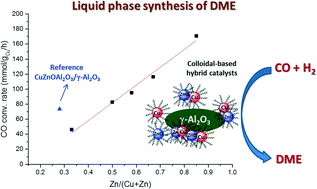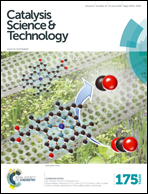A one-step Cu/ZnO quasi-homogeneous catalyst for DME production from syn-gas†
Abstract
A simple one-pot synthetic method allows the preparation of hybrid catalysts, based on colloidal Cu/ZnO nanoparticles (NPs), used for the liquid phase synthesis of DME from syngas. The method obviates the high temperature calcinations and pre-reduction treatments typically associated with such catalysts. The hybrid catalysts are applied under typical industrially relevant conditions. The nature of the hybrid catalysts, the influence of the acid component, mass ratio between components, and Cu/Zn composition are assessed. The best catalysts comprise a colloidal mixture of Cu/ZnO NPs, as the methanol synthesis component, and γ-Al2O3, as the methanol dehydration component. These catalysts show high DME selectivity (65–70% C). Interestingly, the activity (relative to Cu content) is up to three times higher than that for the reference hybrid catalyst based on the commercial Cu/ZnO/Al2O3 methanol synthesis catalyst. The hybrid catalysts are stable for at least 20 h time-on-stream, not showing any significant sintering of the Cu0 phase. Post-catalysis, HR-TEM and STEM/EDX show that the hybrid catalysts consist of Cu0 and ZnO NPs with an average size of 5–7 nm with γ-Al2O3 particles in close proximity.


 Please wait while we load your content...
Please wait while we load your content...